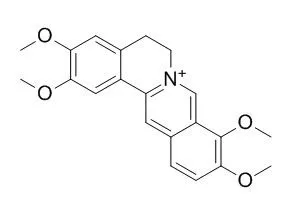| Kinase Assay: |
| Phytochemistry. 1997 Jan;44(2):257-66. | | Biochemical activities of berberine, palmatine and sanguinarine mediating chemical defence against microorganisms and herbivores.[Pubmed: 9004542] | The alkaloids berberine, Palmatine and sanguinarine are toxic to insects and vertebrates and inhibit the multiplication of bacteria, fungi and viruses.
Biochemical properties which may contribute to these allelochemical activities were analysed.
METHODS AND RESULTS:
Acetylcholine esterase, butyrylcholinesterase, choline acetyl transferase, alpha 1- and alpha 2-adrenergic, nicotinergic, muscarinergic and serotonin2 receptors were substantially affected. Sanguinarine appears to be the most effective inhibitor of choline acetyl-transferase (IC50 284 nM), while the protoberberines were inactive at this target. Berberine and Palmatine were most active at the alpha 2-receptor (binding with IC50 476 and 956 nM, respectively). Furthermore, berberine and sanguinarine intercalate DNA, inhibit DNA synthesis and reverse transcriptase. In addition, sanguinarine (but not berberine) affects membrane permeability and berberine protein biosynthesis.
CONCLUSIONS:
In consequence, these biochemical activities may mediate chemical defence against microorganisms, viruses and herbivores in the plants producing these alkaloids. |
|
| Cell Research: |
| Toxicol In Vitro. 2014 Jun;28(4):693-9. | | Palmatine activates AhR and upregulates CYP1A activity in HepG2 cells but not in human hepatocytes.[Pubmed: 24583342] | The protoberberine alkaloid Palmatine is present in preparations from medicinal plants such as Coptis chinensis and Corydalis yanhusuo.
METHODS AND RESULTS:
This study examined whether Palmatine affects the expression of cytochromes P450 (CYPs) 1A1 and 1A2 in primary cultures of human hepatocytes and human hepatoma HepG2 cells grown as monolayer or spheroids. Gene reporter assays showed that Palmatine significantly activated the aryl hydrocarbon receptor (AhR) and increased the activity of CYP1A1 gene promoter in transiently transfected HepG2 cells. In HepG2 monolayer culture, Palmatine also significantly increased mRNA and activity levels of CYP1A1, albeit with considerably less potency than 2,3,7,8-tetrachlorodibenzo-p-dioxin, a prototypical CYP1A inducer. On the other hand, CYP1A activity was not significantly elevated by Palmatine in HepG2 spheroids. Moreover, Palmatine induced mild or negligible changes in CYP1A1 and CYP1A2 mRNA expression without affecting CYP1A activity levels in primary human hepatocytes.
CONCLUSIONS:
It is concluded that Palmatine activates the AhR-CYP1A pathway in HepG2 monolayer, while the potential for CYP1A induction is irrelevant in cell systems which are closer to the in vivo situation, i.e. in HepG2 spheroids and primary cultures of human hepatocytes. Possible induction of CYP1A enzymes by Palmatine in vivo remains to be investigated. |
|
| Animal Research: |
| Pharmacol Rep. 2014 Feb;66(1):1-9. | | Behavioral and biochemical evidences for antidepressant-like activity of palmatine in mice subjected to chronic unpredictable mild stress.[Pubmed: 24905299 ] | In the present study, antidepressant-like activity of Palmatine was evaluated in unstressed and stressed young male Swiss albino mice.
METHODS AND RESULTS:
The animals were subjected to unpredictable mild stress daily for 21 successive days to induce depression-like behavior. Palmatine (0.25, 0.5, 1 mg/kg, ip) was administered for 21 successive days to unstressed and stressed mice. The antidepressant-like activity was evaluated using the tail suspension test, forced swim test and sucrose preference test. Palmatine (0.5 and 1 mg/kg, ip) significantly decreased immobility periods of unstressed and stressed mice in the forced swim test and tail suspension test, thus indicating its significant antidepressant-like activity. Only the highest dose (1 mg/kg) of Palmatine significantly reversed the stress-induced decrease in sucrose preference. There was no significant effect on locomotor activity of the mice by Palmatine and fluoxetine. The antidepressant-like activity of Palmatine was found to be comparable to fluoxetine (10 mg/kg) administered for successive 21 days. Palmatine (0.5 and 1 mg/kg, ip) significantly reversed the stress-induced increase in brain catalase levels, MAO-A activity, lipid peroxidation, plasma nitrite and corticosterone levels.
CONCLUSIONS:
Palmatine showed significant antidepressant-like activity in unstressed and stressed mice probably through inhibition of MAO-A activity, decrease in plasma nitrite levels and due to its antioxidant activity. In addition, Palmatine also showed antidepressant-like activity in stressed mice probably through decrease in plasma corticosterone levels. | | Phytother Res. 2015 May;29(5):668-73. | | Hypolipidemic Effect and Mechanism of Palmatine from Coptis chinensis in Hamsters Fed High-Fat diet.[Pubmed: 25586479] | Palmatine (PAL) is one of the main alkaloids in Coptis chinensis. The present aim was to investigate the hypolipidemic effect and mechanism of Palmatine in hamsters fed with high-fat diet (HFD).
METHODS AND RESULTS:
PAL treatment decreased serum total cholesterol (TC), triglyceride (TG), and low-density lipoprotein cholesterol (LDL-C) levels, as well as increased fecal excretion of TC and total bile acids (TBA) in hyperlipidemic hamsters. Furthermore, PAL treatment up-regulated low-density lipoprotein receptor (LDLR) and cholesterol 7α-hydroxylase (CYP7A1) mRNA and protein expression and down-regulated apical sodium-dependent bile salt transporter (ASBT) mRNA and protein expression. These results demonstrated that PAL as a potential natural cholesterol lowering agent works by up-regulating LDLR and CYP7A1 mRNA and protein expression, down-regulating ASBT mRNA and protein expression, as well as enhancing fecal excretion of TC and TBA.
CONCLUSIONS:
The findings in our study suggest that Palmatine could be a potential natural agent for treating hyperlipidemia. |
|






 Cell. 2018 Jan 11;172(1-2):249-261.e12. doi: 10.1016/j.cell.2017.12.019.IF=36.216(2019)
Cell. 2018 Jan 11;172(1-2):249-261.e12. doi: 10.1016/j.cell.2017.12.019.IF=36.216(2019) Cell Metab. 2020 Mar 3;31(3):534-548.e5. doi: 10.1016/j.cmet.2020.01.002.IF=22.415(2019)
Cell Metab. 2020 Mar 3;31(3):534-548.e5. doi: 10.1016/j.cmet.2020.01.002.IF=22.415(2019) Mol Cell. 2017 Nov 16;68(4):673-685.e6. doi: 10.1016/j.molcel.2017.10.022.IF=14.548(2019)
Mol Cell. 2017 Nov 16;68(4):673-685.e6. doi: 10.1016/j.molcel.2017.10.022.IF=14.548(2019)